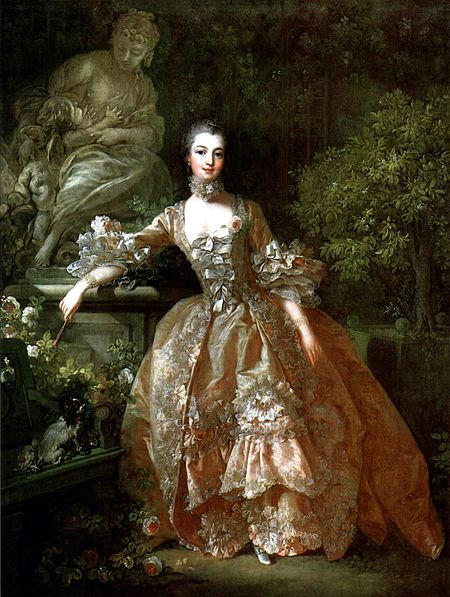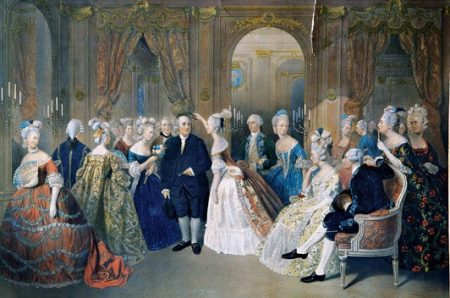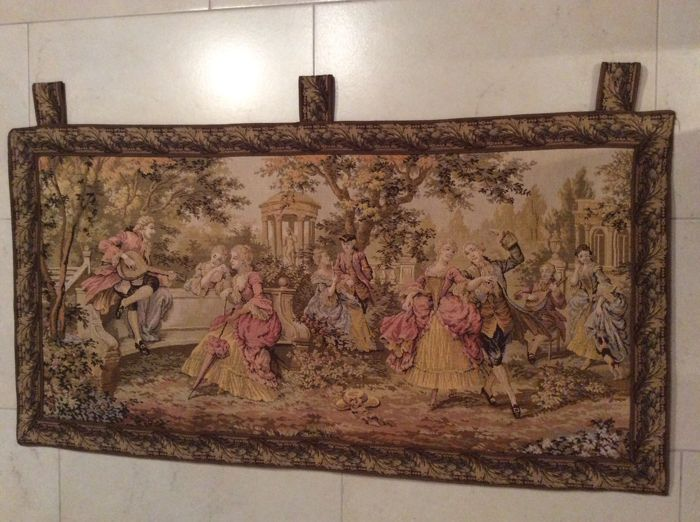In the story Shimotsuma Monogatari, renamed Kamikaze Girls in the English translation, the main character Momoko expresses her adoration for 18th century life in Versailles. I often revisit this novella and the movie when I want to get in the lolita spirit, but as a self-proclaimed history buff, I tend to have a hard time getting through the parts where Momoko imagines what life was like. In this series, I’ll do my best to dispel and explain the bits that Momoko, and to that extent, Novala Takemoto got right – and wrong about life in 18th century France.
 In the last entry, I’ve deconstructed the first page of Kamikaze Girls and explained the differences between Baroque and Rococo, and its significance in Western art history. In this entry, I will share my research on several prolific ladies of 18th century Versailles.
In the last entry, I’ve deconstructed the first page of Kamikaze Girls and explained the differences between Baroque and Rococo, and its significance in Western art history. In this entry, I will share my research on several prolific ladies of 18th century Versailles.
The second page of Kamikaze Girls talks about Queen Marie Antoinette and how she infamously told her starving subjects, “Let them eat cake!”. According to Smithsonian Magazine and Lucy Worsley’s PBS documentary on the doomed queen (among many publications I’ve poured over), there is no evidence that the unfortunate queen ever said such a thing.

Portrait of Queen Marie-Antoinette by Elizabeth Vigée-Lebrun
There are several possibilities for this phenomenon. The phrase was originally written by French philosopher Jean-Jacques Rousseau in his treatise called, “Confessions”. Historians argue that it is possible that he has turned the expression himself, or that the words were originally said by Princess Maria-Theresa of Spain who married King Louis XIV more than a century before Marie Antoinette set foot in France. It was also alluded to by Marie Antoinette’s aunts. Either way, there is no significant proof that these words were written or said by Marie Antoinette herself, who was quite known for being a tender-hearted queen. It is likely that this phrase was used against her by political enemies who sought to scapegoat her for her spend-thrift habits and pro-royalty stance during political and economical upheaval. Perhaps it was easier to blame bad harvests and high taxes on a foreign woman on the throne than it was to acknowledge deficits on the wars France involved themselves with abroad.
An interesting note on the phrase, “Let them eat cake”. Apparently this isn’t the original phrase, but rather, “Qu’ils mangent de la brioche” - Let them eat brioche, a type of thick-eggy bread. There is an old French law that required bakeries to sell the more expensive brioche at the same price as the regular bread when supplies of the latter were out. Unfortunately, this law had put the poor peasants at the short end of the stick when bakeries chose to save themselves by selling very short supplies of the regular bread.

I guess “Let them eat an eggy-bread” doesn’t exactly roll off the tongue well.
Marie Antoinette is an interesting and complicated figure whom I believe deserves more credit and humanity than old history books have said about her. If you’d like to learn more about the doomed queen, check out these links below:
https://tinyurl.com/lworsley-mantoinette
https://tinyurl.com/historymantoinettescandals
https://tinyurl.com/mantoinettesmithsonian

Portrait of Madame de Pompadour by François Boucher
Momoko/Novala goes on to praise Madame de Pompadour for starting life from a low-social standing to working her way up the ranks and becoming King Louis XV’s favorite mistress, thus controlling the throne behind the shadows. Once again, Momoko/Novala are only half right. Born Jeanne-Antoinette Poisson, she was the daughter of François Poisson, a financier, and Madeleine de la Motte. There are rumors that Jeanne was an illegitimate daughter of another financier, either Jean Pâris de Monmartel or Charles François Paul Le Normant de Tournehem. Whoever the real father was, François was exiled for fraud throughout her childhood and Le Normant de Tournehem became her legal guardian in 1725.

Painting of Benjamin Franklin visiting a salon in France
Jeanne-Antoinette wasn’t exactly from a low social standing as Momoko/Novala claims. Typically, the French particles d’, du, and de in a surname indicates nobility. Perhaps she was not born to nobility, but she was born and raised by a very well-to-do family and was extremely fortunate to have started off her education in an Ursuline convent in Poissy (she would later return home due to poor health, but still received the best education for her time).
Her adopted father brought her up for high society and arranged for her to marry his nephew. She married and moved to Château d’Etiolles, just outside Paris at the age of 19 in 1741. Her marriage gave her access to the salon scene of Paris where she would have been introduced to many great figures of the Enlightenment and where she honed the art of conversation. She’d later cultivate her own private salon at Etiolles for the cultural and intellectual elite of her time. This involvement in the great Parisian salons helped put her foot at the door of Versailles.
In true Capricorn fashion, Jeanne-Antoinette was ambitious and wanted more in life than to be a wife and mother as expected by society. There are accounts that her mother sought out a fortune teller who predicted that Jeanne-Antoinette would win the heart of a king, but I suspect the unfulfilling and rigid gender roles, her involvement in the salons, and perhaps even loss both her children influenced her to cast aside societal expectations and launch a career in the royal court.
Whether the prophecy was true or not, it was known that she would deliberately ride on horseback during the king’s hunts hoping to catch his attention, and was later invited to a masquerade ball where he had declared his affections for her. Needless to say, it did not take long for her to move into the palace with her own apartments above his, and she was determined to remain his favorite mistress. Jeanne-Antoinette then arranged for a formal separation from her family and the king entitled her Marquise de Pompadour.
It was not uncommon for royal mistresses to wield influence behind the throne, but Madame de Pompadour was unusual in her ability to control court, domestic, and international affairs, and she was unapologetic about it, much to her peer’s chagrin. She was also quite controversial among Church officials. Madame de Pompadour was a strong supporter of creation of the French Encyclopedia which the Catholic Church worked to have it banned. With Voltaire being one of her closest allies, Madame de Pompadour challenged the legitimacy of the current world order and promoted scientific thought. This assertion of control eventually became her Achilles' heel when she convinced the king to end their alliance with Prussia and to support Austria instead, and thus, she was indirectly blamed for France’s humiliating defeat during the Seven Years War. Due to the king’s declining popularity and her own poor health (she had previously suffered many miscarriages and eventually died of pneumonia), Madame de Pompadour wisely lessened her influence in political affairs.
What really made Madame de Pompadour a Rococo icon is her influence in the arts. She was a notorious patron of commercial art. When she acquired her many lodges and châteaus, she’d decorate them with works made by artists like Charles-André van Loo and Boucher. Everyday objects were made with luxury in mind. The effect was so that she and the king could enjoy their privacy together among beautiful surroundings. She was especially known for her love of porcelain and was an important promoter of French manufacturing, transforming the Sèvres porcelain and Gobelin tapestry fortunes.

Example of an 18th century Gobelin tapestry

A piece of 18th century Sevrès decorative porcelain
https://tinyurl.com/18thcenturysalons
More on Madame de Pompadour
https://tinyurl.com/ukgallery-mdmdupompadour
https://tinyurl.com/francetoday-mdmdepomadour
Now, the person who was certainly of low-standing and worked her way up behind the king’s throne is Madame du Barry, the last royal mistress of King Louis XV. There are many conflicting and biased statements on the life of Madame du Barry, but I will do my best to tell her story. Born Jeanne Bécu, Madame du Barry was also an illegitimate child, although born into the servant class; her mother was a seamstress and her father was (possibly) a local friar.

Madame du Barry by Elizabeth Vigée-LebrunSimilarly to Madame de Pompadour, Jeanne was afforded the luxury of a convent education through some strange luck - her mother was a cook for Francesca, an infamous Italian courtesan and mistress of a Monsieur Billiard-Dumonceaux (he was possibly the father of Jeanne’s half-brother). The mistress was very fond of the little girl and lavished her with gifts while Dumonceaux funded her education.
When Jeanne was a teenager, her mother eventually married; without Dumonceaux’s financial support she left the convent, and they had moved out of the courtesan’s home. Her mother’s new husband had less income and so in order to support herself, she held a number of odd-jobs including selling trinkets in the streets of Paris. Allegedly, during her teenage years, she was unable to hold jobs very long for her beauty had often attracted meddling affairs. With little financial prospects and no adult protections, Jeanne eventually resorted to entertaining at a casino-brothel. Her beauty caught the attention of Jean-Baptiste du Barry, a high class pimp/procurer who instilled her as his mistress and brought her up to become a courtesan for the wealthy elite. During her stint with le Roué (the vile), as compte du Barry was often known as, she caught the attention of the king while running an errand to Versailles (for she had many lovers and clients within the king’s closest circles). Le Roué noticed this and planned to use her to gain favours from the king. Her presence at Versailles ruffled feathers as she was mingling with people far above her station - it is protocol for official court mistresses to be someone of nobility. This was remedied by an arranged (false) marriage between Jeanne and the compte’s brother.
Unlike Madame de Pompadour, Madame du Barry was not very politically inclined nor ambitious, preferring to use her status as the king’s new favorite to live in the lap of luxury as she had in her childhood. Her costly love of decorating and fashion, as well as her status made many enemies among the court. Unfortunately for Madame du Barry, the king was getting on in years, and as soon as he died of smallpox, she was quickly banned from ever returning to court.
More on Madame du Barry:
http://thisisversaillesmadame.blogspot.com/2013/04/jeanne-becu-madame-du-barry.html
https://tinyurl.com/digitallibraryduberry
Let us know what you think about these ladies in the comments below. Could you endure life as a royal mistress?
Thanks for reading!
Mocha
PS: If you missed Part 1 of this series, please go check it out, and Part 3 is up as well!

